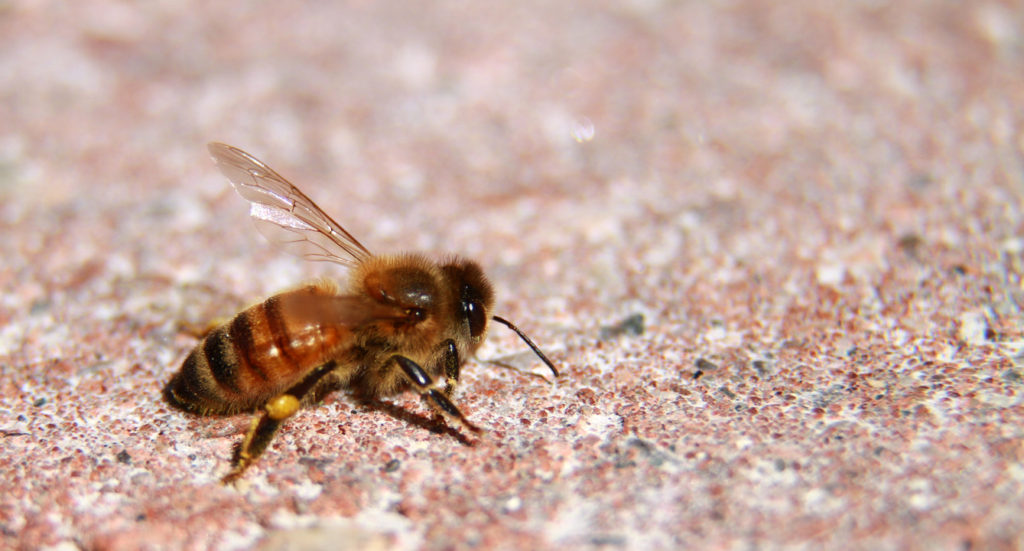Identifying a Honey Bee

“Help! I’ve got honey bees in my house!”
As summer approaches, we start to get a lot more calls for “bees.” I put “bees” in quotation marks because often “bee” is a catch-all phrase people will use to refer to any and all stinging insects. Yellow jackets, carpenter bees, honey bees, bald faced hornets, mud dauber wasps and everything in between are called “bees.”
People will often call and say they think they have a honey bee infestation. Honey bees are of particular concern, for two reasons. First, removing honey bees from a home can be a major hassle. Besides removing the hive, the bees will often have constructed massive honey combs in walls or ceilings that can only be removed at great expense. Second, honey bee populations in the United States are going into steep decline due to a phenomenon known as “colony collapse disorder.” Because of this, Northern Pest – and many pest control companies – do not like to exterminate honey bees. We prefer live extraction methods that allow us to remove the honey bee colony intact and relocate it to a new hive. So, the manner in which honey bees are treated is totally unique to other stinging insects.
This article will help you diagnose whether the “bees” you are seeing are honey bees or not.
Are they furry?
If the insect you are seeing does not appear to be furry – if its abdomen is smooth – you are not dealing with a honey bee. Honey bees are furry. Please note, the presence of fur/hair does not mean you necessarily have honey bees, as other species of bee also have fur (bumble bees, for example). But if there is no hair, it is definitely not a honey bee.
Are they swarming in very large numbers?
Perhaps the most distinguishing mark of honey bees is their tendency to congregate in very large, densely packed swarms. What constitutes a “swarm”? While there is no particular definition of how many bees you need to have a swarm, let’s just say that typically we are talking about hundreds, not just a couple. And typically the swarm is very densely packed together. Below left you can see a picture of what an authentic honey bee swarm looks like.
Honey bees are really the only stinging insect that swarm in this fashion, so unless you seeing a swarm that looks comparable to this, you are not dealing with honey bees.
Are they flying fast or slow?
Honey bees fly very swiftly. If the insect you are seeing could be described as slow moving, it’s probably not a honey bee. Yellow jackets are often mistaken for honey bees, but an examination of the flight patterns of yellow jackets and honey bees makes it very easy to tell the two apart. Yellow jackets have a very slow, hovering, almost drooping sort of flight pattern. It is extremely different from very swift, frenzied flight of swarming honey bees.
Are they fat and round?
Honey bees are not generally considered “fat” or “round.” If the bee you are seeing is very large, fat, or could be described as “round” in shape, you are probably seeing a bumble bee or a carpenter bee. The latter especially are known for their distinctive large, round shape. Honey bees are more elongated than carpenter bees.
Are they coming out of round holes?
If the bees you are seeing are climbing in and out of perfectly round holes in wood siding or wood trim, these are not honey bees but carpenter bees. Carpenter bees make distinctive circular holes to lay their young in. The holes are so circular, they look like they could have been made by a drill bit.
Are they orange-brown, or are they bright yellow and black?
Honey bees are not bright yellow. They have what can best be described as a “rusty” sort of color, typically hues of orange-brown with black markings on the abdomen. Yellow jackets, on the other hand, are very bright yellow with black stripes. Carpenter bees are also a bright yellow color with a shiny black abdomen and a black circle on their back (females also have black faces).
Conclusion
Based on the questions we have considered, you can be sure you are dealing with a honey bees if they:
- Have fur
- Are swarming
- Fly swiftly
- Are moderately elongated
- Are not living in round holes bored in wood
- Are a “rusty” orange-brown color
If the stinging insects you are seeing fits all these descriptions, you are probably seeing honey bees. If not, its probably a yellow jacket, carpenter bee, or some other kind of stinging insect.